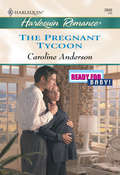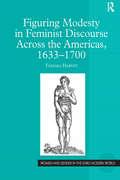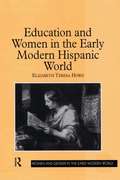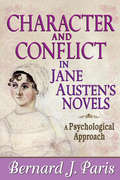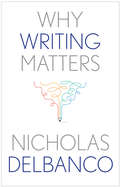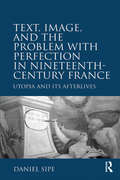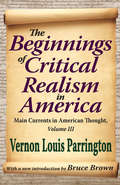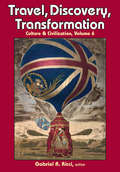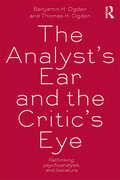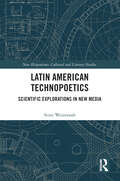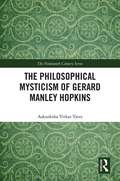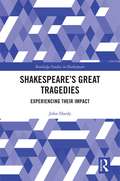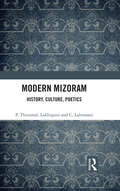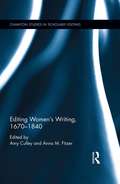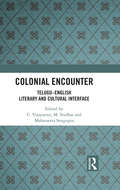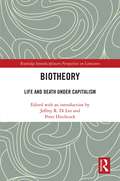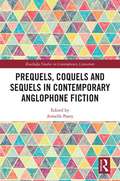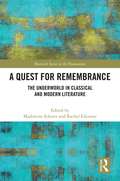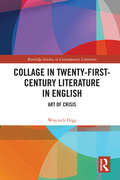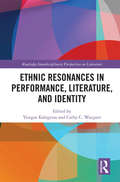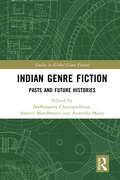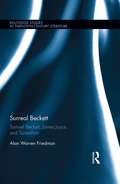- Table View
- List View
The Pregnant Tycoon (Mills And Boon Cherish Ser.)
by Caroline AndersonRich and successful, Izzy Brooke has everything–except love. Determined to change her life, she is reunited with single dad Will Thompson, the boyfriend she had as a teenager.
Figuring Modesty in Feminist Discourse Across the Americas, 1633-1700 (Women and Gender in the Early Modern World)
by Tamara HarveyInventive in its approach and provocative in its analysis, this study offers fresh readings of the arguments and practices of four seventeenth-century Euro-American women: Anne Bradstreet, Anne Hutchinson, Sor Juana Inés de la Cruz, and Marie de l'Incarnation. Tamara Harvey here compares functionalist treatments of the body by these women, offering a new way to think of corporeality as a device in literary and religious expressions of modesty by women. In doing so, Harvey explores the engagement of these women in ongoing religious, political, scientific and social debates that would have been understood by the authors' contemporaries in both Europe and America.
Education and Women in the Early Modern Hispanic World (Women and Gender in the Early Modern World)
by Elizabeth Teresa HoweConsidering the presence and influence of educated women of letters in Spain and New Spain, this study looks at the life and work of early modern women who advocated by word or example for the education of women. The subjects of the book include not only such familiar figures as Sor Juana and Santa Teresa de Jesús, but also of less well known women of their time. The author uses primary documents, published works, artwork, and critical sources drawn from history, literature, theatre, philosophy, women's studies, education and science. Her analysis juxtaposes theories espoused by men and women of the period concerning the aptitude and appropriateness of educating women with the actual practices to be found in convents, schools, court, theaters and homes. What emerges is a fuller picture of women's learning in the early modern period.
Character and Conflict in Jane Austen's Novels: A Psychological Approach
by Bernard J. ParisIn Character and Conflict in Jane Austen's Novels , Bernard J. Paris offers an analysis of the protagonists in four of Jane Austen's most popular novels. His analysis reveals them to be brilliant mimetic creations who often break free of the formal and thematic limitations placed upon them by Austen. Paris traces the powerful tensions between form, theme, and mimesis in Mansfield Park , Emma , Pride and Prejudice , and Persuasion . Paris uses Northrop Frye's theory of comic forms to analyse and describe the formal structure of the novels, and Karen Horney's psychological theories to explore the personalities and inner conflicts of the main characters. The concluding chapter turns from the characters to their creator, employing the Horneyan categories of self-effacing, detached, and expansive personality types to interpret Jane Austen's own personality. Readers of Jane Austen will find much that is new and challenging in this study. It is one of the few books to recognise and pay tribute to Jane Austen's genius in characterisation. Anyone who reads this book will come away with a new understanding of Austen's heroines as imagined human beings and also with a deeper feeling for the troubled humanity of the author herself.
Why Writing Matters (Why X Matters Series)
by Nicholas DelbancoDrawing lessons from writers of all ages and writing across genres, a distinguished teacher and writer reveals the enduring importance of writing for our time In this new contribution to Yale University Press’s Why X Matters series, a distinguished writer and scholar tackles central questions of the discipline of writing. Drawing on his own experience with mentors such as John Updike, John Gardner, and James Baldwin, and in turn having taught such rising stars as Jesmyn Ward, Delbanco looks in particular at questions of influence and the contradictory, simultaneous impulses toward imitation and originality. Part memoir, part literary history, and part analysis, this unique text will resonate with students, writers, writing teachers, and bibliophiles.
Text, Image, and the Problem with Perfection in Nineteenth-Century France: Utopia and Its Afterlives
by Daniel SipeIn the decades after the French Revolution, philosophers, artists, and social scientists set out to chart and build a way to a new world and their speculative blueprints circulated like banknotes in a parallel economy of ideas. Examining representations of ideal societies in nineteenth-century French culture, Daniel Sipe argues that the dream-image of the literary or art-historical utopia does not disappear but rather is profoundly altered by its proximity to the social utopianism of the day. Sipe focuses on this persistent afterlife in utopias ranging from François-René de Chateaubriand’s Amerindian utopia in Atala (1801) to the utopian spoof of J.J. Grandville’s illustrated novel Un autre monde (1844). He proposes a new reading of Etienne Cabet’s seminal utopian novel, Voyage en Icarie (1840) and offers an original perspective on the gendered utopias of technological inspiration that authors such as Charles Barbara and Auguste Villiers de l’Isle-Adam penned in the second half of the century. In addition, Sipe considers utopias or important readings of the century’s rampant utopianism in, among others, Victor Hugo, Alfred de Vigny, Théophile Gautier, Charles Baudelaire, and Gustave Courbet. His book provides the historical context for comprehending the significance and implications of this enigmatic afterlife in nineteenth-century utopian art and literature.
The Beginnings of Critical Realism in America: Main Currents in American Thought
by Vernon ParringtonThis final volume of Vernon Louis Parrington's Pultzer Prize-winning study deals with the decay of romantic optimism. It shows that the cause of decay is attributed to three sources: stratifying of economics under the pressure of centralization; the rise of mechanistic science; and the emergence of a spirit of skepticism which, with teachings of the sciences and lessons of intellectuals, has resulted in the questioning of democratic ideals.Parrington presents the movement of liberalism from 1913 to 1917, and the reaction to it following World War I. He notes that liberals announced that democratic hopes had not been fulfilled; the Constitution was not a democratic instrument nor was it intended to be; and while Americans had professed to create a democracy, they had in fact created a plutocracy.Industrialization of America under the leadership of the middle class and the rise of critical attitudes towards the ideals and handiwork of that class are examined in great detail. Parrington's interpretation of the literature during this time focuses on four divisions of development: the conquest of America by the middle class; the challenge of that overlordship by democratic agrarianism; the intellectual revolution brought about by science and the appropriation of science by the middle class; and the rise of detached criticism by younger intellectuals. A new introduction by Bruce Brown highlights Parrington's life and explains the importance of this volume.
Travel, Discovery, Transformation
by Gabriel R. RicciThis latest volume in the Culture & Civilization series gathers interdisciplinary voices to present a collection of essays on travel and travel narratives. The essays span a range of topics from iconic ancient travel stories to modern tourism. They discuss travel in the ancient world, modern heroic travels, the literary culture of missionary travel, the intersection of fiction and travel narratives, modern literary traditions and visions of Greece, personal identity, and expatriation. Essays also address travel memoirs, the re-imagining of worlds through travel, transformed landscapes and animals in travel narratives, diplomacy, English women travel writers, and pilgrimage and health in the medieval world.The history of travel writing takes in multiple pursuits: exploration and conquest, religious pilgrimage and missionary work, educational tourism and diplomacy, scientific and personal discovery, and natural history and oral history. As a literary genre, it has enhanced a wide range of disciplines, including geography, ethnography, anthropology, and linguistics. Moreover, twenty-first-century interests in travel and travel writing have produced a global framework that promises to expand travel's theoretical reach into the depths of the Internet, thus challenging our conventional concept of what it means to travel.The fact that travel and travel writing have a prehistory that is embedded in foundational religious texts and ancient narratives of journey, like the Odyssey and the Epic of Gilgamesh, makes both travel and travel writing fundamental and essential expressions of humanity. Travel encourages writing, particularly as epistolary and poetic chronicling. This is clearly a history and tradition that began with human communication and which has kept pace with our collective development.
The Analyst's Ear and the Critic's Eye: Rethinking psychoanalysis and literature
by Benjamin H. Ogden Thomas H. OgdenThe Analyst‘s Ear and the Critic‘s Eye is the first volume of literary criticism to be co-authored by a practicing psychoanalyst and a literary critic. The result of this unique collaboration is a lively conversation that not only demonstrates what is most fundamental to each discipline, but creates a joint perspective on reading literature that ne
The Analyst's Ear and the Critic's Eye: Rethinking psychoanalysis and literature
by Benjamin H. Ogden Thomas H. OgdenThe Analyst‘s Ear and the Critic‘s Eye is the first volume of literary criticism to be co-authored by a practicing psychoanalyst and a literary critic. The result of this unique collaboration is a lively conversation that not only demonstrates what is most fundamental to each discipline, but creates a joint perspective on reading literature that ne
Latin American Technopoetics: Scientific Explorations in New Media (New Hispanisms: Cultural and Literary Studies)
by Scott WeintraubLatin American Technopoetics: Scientific Explorations in New Media analyzes the ways in which poetry and multimedia installations by six prominent poets and artists engage, and in turn are engaged by, scientific discourses. In its innovative readings of contemporary digital media works, Latin American Technopoetics is the first book to investigate the powerful dialogue between recent techno-cultural phenomena, literature, and various scientific fields. This cutting-edge analysis of poetic and artistic experimentation—robots that compose and recite poetry, algorithms that create visualizations of poetic language or of the connections between everyday language and scientific terminology, arrays of multi-dimensional poetic spaces, and telematic and transgenic art—makes a strong case for the increasing viability of a scientific poetics currently gaining prominence in Latin American literary and media studies, digital humanities, and science and technology studies.
The Philosophical Mysticism of Gerard Manley Hopkins (The Nineteenth Century Series)
by Aakanksha Virkar YatesThrough the lens of Hopkins's 'masterwork', The Philosophical Mysticism of Gerard Manley Hopkins readdresses Hopkins's frequently overlooked mysticism as an interior narrative within his corpus. Drawing on a range of religious, literary and visual traditions from Augustine's Confessions to the seventeenth-century spiritual emblem, this book demonstrates the ways in which the Wreck deliberately constructs and conceals a mystical and contemplative narrative. Typology and allegory are some of the important hermeneutic tools used in this re-reading of Hopkins, relating the poet to the discursive tradition surrounding the Old Testament Song of Songs, the philosophical theology of the Greek Fathers, and, perhaps most intriguingly, the meditative and visual tradition of the baroque heart-emblem. On the centenary of the publication of Hopkins’s poems, this book places the writer firmly within a mystical tradition, necessitating a fundamental reconsideration of the legacy of this major Victorian poet.
Shakespeare's Great Tragedies: Experiencing Their Impact (Routledge Studies in Shakespeare)
by John HardyShakespeare's great tragedies portray through their richly imagined worlds the inescapable fact of human mortality. As the work of a great creative genius, they are so diverse that critical formulas used to describe their overall impact tend to be somewhat suspect. Their impact follows from a response to the entire dramatic action, what is felt at the end with the weight or experience of the whole play behind it. It draws on how our feelings and judgement are exercised and engaged throughout the drama. Shakespeare portrays what life can be like, without pandering to the wish for something easier to contemplate. Something more invigorating than consolation is provided, such art at its greatest achieving the strength of truth. What it compels is a complex acceptance, reflected in Edgar's words, "The weight of this sad time we must obey". Not only implicit positives give value to these plays. Their significance finally results from what they imaginatively invite their audience to experience and witness. This gives a sense not only of the value of life, but also of what can threaten it.
Modern Mizoram: History, Culture, Poetics
by P. Thirumal Laldinpuii C. LalrozamiMizoram is situated at a unique cusp in North East India, in terms of both physical and social contexts. It shares its borders with Myanmar and Bangladesh, while cultural influences range from the indigenous to the Western. This book offers an alternative understanding of the modern history of Mizoram through an analysis of its cultural practices through language, music, poetry and festivals. It explores the roots of modern cultural works not just in Christianity, but also in precolonial Mizo traditional practices. The authors closely examine text, performance and sculptural images, including the first handwritten newspaper Mizo Chanchin Laisuih (1898) and the Puma Zai festival (1907–11) from the early colonial period along with a contemporary sculptural image. They argue that cultural works open up to new forms of interpretations and responses over time. The book indicates that the Mizo creative sensibility enmeshed in theological, capitalistic-material and political/ideological regimes informs its modern enclosures, be it region, religion or nation. This book will be of great interest to scholars and researchers of cultural studies, literature, media, history, politics, sociology and social anthropology, area studies, North East India studies and South Asian studies.
Editing Women's Writing, 1670-1840 (Chawton Studies in Scholarly Editing)
by Amy Culley Anna M. FitzerThis edited volume is the first to reflect on the theory and practice of editing women’s writing of the 18th century. The list of contributors includes experts on the fiction, drama, poetry, life-writing, diaries and correspondence of familiar and lesser known women, including Jane Austen, Delarivier Manley, Eliza Haywood and Mary Robinson. Contributions examine the demands of editing female authors more familiar to a wider readership such as Elizabeth Montagu, Mary Robinson and Helen Maria Williams, as well as the challenges and opportunities presented by the recovery of authors such as Sarah Green, Charlotte Bury and Alicia LeFanu. The interpretative possibilities of editing works published anonymously and pseudonymously are considered across a range of genres. Collectively these discussions examine the interrelation of editing and textual criticism and show how new editions might transform understandings not only of the woman writer and women’s literary history, but also of our own editorial practice.
Colonial Encounter: Telugu–English Literary and Cultural Interface
by C. Vijayasree M. Sridhar Mahasweta SenguptaThis book focuses on transactions between English and Telugu through a study of translations and related works published from about the early-nineteenth century to mid-twentieth century. Moving beyond Edward Said’s theoretical paradigms which suggest that these interfaces were driven by imperial and colonial interests, the essays in this volume look at how they also triggered developments within the indigenous literary and cultural practices and evolved new forms of expression. The book will be of great interest to scholars and researchers of linguistics, translation studies, comparative literature, cultural studies and modern South Asian history.
Biotheory: Life and Death under Capitalism (Routledge Interdisciplinary Perspectives on Literature)
by Jeffrey R. Di Leo Peter HitchcockForged at the intersection of intense interest in the pertinence and uses of biopolitics and biopower, this volume analyzes theoretical and practical paradigms for understanding and challenging the socioeconomic determinations of life and death in contemporary capitalism. Its contributors offer a series of trenchant interdisciplinary critiques, each one taking on both the specific dimensions of biopolitics and the deeper genealogies of cultural logic and structure that crucially inform its impress. New ways to think about biopolitics as an explanatory model are offered, and the subject of bios (life, ways of life) itself is taken into innovative theoretical possibilities. On the one hand, biopolitics is addressed in terms of its contributions to forms and divisions of knowledge; on the other, its capacity for reformulation is assessed before the most pressing concerns of contemporary living. It is a must read for anyone concerned with the study of bios in its theoretical profusions.
Prequels, Coquels and Sequels in Contemporary Anglophone Fiction
by Armelle PareyThis book offers to delineate a key phenomenon in contemporary Anglophone fiction: novel expansion, when the plot and characters from a finished novel are retrieved to be developed in new adventures set before, after or during the narrative time of the source-text. If autographic and allographic sequels are almost as old as literature, prequels – that imagine the anteriority of a narrative – and coquels – that develop secondary characters in the same story time as the source-text – are more recent. The overall trend for novel expansion spread in the mid-1980s and 1990s and has since shown no sign of abating. This volume is organised following three types of relationships to the source-texts even if these occasionally combine to produce a more complex structure. This book comprises 11 essays, preceded by an introduction, that examine narrative strategies, aesthetic, ethical and political tendencies underlying these novel expansions. Following the overview provided in the introduction, the reader will find case studies of prequels, coquels and sequels before a final chapter that encompasses them all and more.
A Quest for Remembrance: The Underworld in Classical and Modern Literature (Warwick Series in the Humanities)
by Rachel Falconer Madeleine SchererA Quest for Remembrance: The Underworld in Classical and Modern literature brings together a range of arguments exploring connections between the descent into the underworld, also known as katabasis, and various forms of memory. Its chapters investigate the uses of the descent topos both in antiquity and in the reception of classical literature in the nineteenth to twenty-first centuries. In the process, the volume explores how the hero’s quest into the underworld engages with the theme of recovering memories from the past. At the same time, we aim to foreground how the narrative format itself is concerned with forms of commemoration ranging from trans-cultural memory, remembering the literary and intellectual canon, to commemorating important historical events that might otherwise be forgotten. Through highlighting this duality this collection aims to introduce the descent narrative as its own literary genre, a ‘memorious genre’ related to but distinct from the quest narrative.
Collage in Twenty-First-Century Literature in English: Art of Crisis (Routledge Studies in Contemporary Literature)
by Wojciech DragCollage in Twenty-First-Century Literature in English: Art of Crisis considers the phenomenon of the continued relevance of collage, a form established over a hundred years ago, to contemporary literature. It argues that collage is a perfect artistic vehicle to represent the crisis-ridden reality of the twenty-first-century. Being a mixture of fragmentary incompatible voices, collage embodies the chaos of the media-dominated world. Examining the artistic, sociopolitical and personal crises addressed in contemporary collage literature, the book argues that the 21st Century has brought a revival of collage-like novels and essays.
Ethnic Resonances in Performance, Literature, and Identity (Routledge Interdisciplinary Perspectives on Literature)
by Yiorgos Kalogeras Cathy C. WaegnerThis volume seeks to weave applications of the dynamic concept of resonance to ethnic studies. Resonance refers to the ever broadening, multidirectional effects of movement or action, a concept significant for many disciplines. The individual chapters exchange the concept of static "intertextuality" for that of interactive "resonance," which encourages consideration of the mutual and processual influences among readings, paradigms, and social engagement in cultural analysis. International scholars of literary and cultural studies, linguistics, history, politics, or ethno-environmental studies contribute their work in this volume. Each chapter examines a specific ethnic phenomenon in terms of relevant literature, lived experience and theoretical approaches, or historical intervention, relating the given case study to parameters of resonance. The book offers dialogic transnational interchange, a play of eclectic ethnic voices, inquiries, perspectives, and differences. The studies in this interdisciplinary volume show that – through resonant engagement with(in) and between works – literary production can both enhance and disturb cultural narratives of ethnicity.
Prequels, Coquels and Sequels in Contemporary Anglophone Fiction
by Armelle PareyThis book offers to delineate a key phenomenon in contemporary Anglophone fiction: novel expansion, when the plot and characters from a finished novel are retrieved to be developed in new adventures set before, after or during the narrative time of the source-text. If autographic and allographic sequels are almost as old as literature, prequels – that imagine the anteriority of a narrative – and coquels – that develop secondary characters in the same story time as the source-text – are more recent. The overall trend for novel expansion spread in the mid-1980s and 1990s and has since shown no sign of abating. This volume is organised following three types of relationships to the source-texts even if these occasionally combine to produce a more complex structure. This book comprises 11 essays, preceded by an introduction, that examine narrative strategies, aesthetic, ethical and political tendencies underlying these novel expansions. Following the overview provided in the introduction, the reader will find case studies of prequels, coquels and sequels before a final chapter that encompasses them all and more.
Indian Genre Fiction: Pasts and Future Histories (Studies in Global Genre Fiction)
by Bodhisattva Chattopadhyay Aakriti Mandhwani Anwesha MaityThis volume maps the breadth and domain of genre literature in India across seven languages (Tamil, Urdu, Bangla, Hindi, Odia, Marathi and English) and nine genres for the first time. Over the last few decades, detective/crime fiction and especially science fiction/fantasy have slowly made their way into university curricula and consideration by literary critics in India and the West. However, there has been no substantial study of genre fiction in the Indian languages, least of all from a comparative perspective. This volume, with contributions from leading national and international scholars, addresses this lacuna in critical scholarship and provides an overview of diverse genre fictions. Using methods from literary analysis, book history and Indian aesthetic theories, the volume throws light on the variety of contexts in which genre literature is read, activated and used, from political debates surrounding national and regional identities to caste and class conflicts. It shows that Indian genre fiction (including pulp fiction, comics and graphic novels) transmutes across languages, time periods, in translation and through publication processes. While the book focuses on contemporary postcolonial genre literature production, it also draws connections to individual, centuries-long literary traditions of genre literature in the Indian subcontinent. Further, it traces contested hierarchies within these languages as well as current trends in genre fiction criticism. Lucid and comprehensive, this book will be of great interest to academics, students, practitioners, literary critics and historians in the fields of postcolonialism, genre studies, global genre fiction, media and popular culture, South Asian literature, Indian literature, detective fiction, science fiction, romance, crime fiction, horror, mythology, graphic novels, comparative literature and South Asian studies. It will also appeal to the informed general reader.
Surreal Beckett: Samuel Beckett, James Joyce, and Surrealism (Routledge Studies in Twentieth-Century Literature)
by Alan Warren FriedmanSurreal Beckett situates Beckett‘s writings within the context of James Joyce and Surrealism, distinguishing ways in which Beckett forged his own unique path, sometimes in accord with, sometimes at odds with, these two powerful predecessors. Beckett was so deeply enmeshed in Joyce’s circle during his early Paris days (1928 - late 1930s) that James Knowlson dubbed them his "Joyce years." But Surrealism and Surrealists rivaled Joyce for Beckett’s early and continuing attention, if not affection, so that Raymond Federman called 1929-45 Beckett’s "surrealist period." Considering both claims, this volume delves deeper into each argument by obscuring the boundaries between theses differentiating studies. These received wisdoms largely maintain that Beckett’s Joycean connection and influence developed a negative impact in his early works, and that Beckett only found his voice when he broke the connection after Joyce’s death. Beckett came to accept his own inner darkness as his subject matter, writing in French and using a first-person narrative voice in his fiction and competing personal voices in his plays. Critics have mainly viewed Beckett’s Surrealist connections as roughly co-terminus with Joycean ones, and ultimately of little enduring consequence. Surreal Beckett argues that both early influences went much deeper for Beckett as he made his own unique way forward, transforming them, particularly Surrealist ones, into resources that he drew upon his entire career. Ultimately, Beckett endowed his characters with resources sufficient to transcend limitations their surreal circumstances imposed upon them.
Shakespeare's Great Tragedies: Experiencing Their Impact (Routledge Studies in Shakespeare)
by John HardyShakespeare's great tragedies portray through their richly imagined worlds the inescapable fact of human mortality. As the work of a great creative genius, they are so diverse that critical formulas used to describe their overall impact tend to be somewhat suspect. Their impact follows from a response to the entire dramatic action, what is felt at the end with the weight or experience of the whole play behind it. It draws on how our feelings and judgement are exercised and engaged throughout the drama. Shakespeare portrays what life can be like, without pandering to the wish for something easier to contemplate. Something more invigorating than consolation is provided, such art at its greatest achieving the strength of truth. What it compels is a complex acceptance, reflected in Edgar's words, "The weight of this sad time we must obey". Not only implicit positives give value to these plays. Their significance finally results from what they imaginatively invite their audience to experience and witness. This gives a sense not only of the value of life, but also of what can threaten it.
